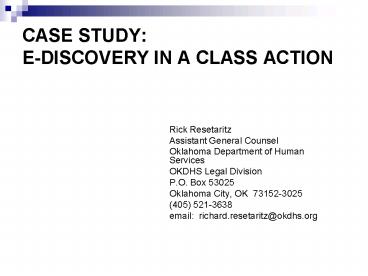CASE STUDY: EDISCOVERY IN A CLASS ACTION - PowerPoint PPT Presentation
1 / 19
Title:
CASE STUDY: EDISCOVERY IN A CLASS ACTION
Description:
Agree on a common search methodology (e.g. keywords) and production format or formats ... Interview key custodians as to where ESI may exist. ... – PowerPoint PPT presentation
Number of Views:45
Avg rating:3.0/5.0
Title: CASE STUDY: EDISCOVERY IN A CLASS ACTION
1
CASE STUDYE-DISCOVERY IN A CLASS ACTION
- Rick Resetaritz
- Assistant General Counsel
- Oklahoma Department of Human Services
- OKDHS Legal Division
- P.O. Box 53025
- Oklahoma City, OK 73152-3025
- (405) 521-3638
- email richard.resetaritz_at_okdhs.org
2
Case Study E-Discovery in a Class Action
- The Oklahoma Department of Human Services IT
environment - 10,364 networked computers including 3200 tablets
- 170 remote site servers
- 150 central servers
- 1 mainframe
- Compliant SACWIS system on an Oracle database
3
E-Discovery in a Class Action continued
- 30 TB of ESI
- 3.5 TB of emails on an Exchange platform
- VTS backup for Exchange
- Storage Capacity of 63 TB
4
In February 2008, a national advocacy
organization filed a federal civil rights lawsuit
seeking certification of a class of 10,000
children.
- Scope of Preservation
- Stored information in any format which relates
in any way to child welfare, foster care, child
care, out-of home care or treatment for children
in legal custody of OKDHS, or child welfare
management, performance, budgets, audits,
funding, contracting, organization, operations,
training, procedures, maltreatment, reporting and
investigations, and personnel.
5
ESTIMATE OF ESI
- 10 TB of potentially relevant ESI on servers and
individual hard drives - 2500 ESI custodians
- Other Locations
- Third-Party Vendors (e.g. University of Oklahoma)
- Multifunction printer hard drives
- Fax machine memory
- Smart phone memory
6
UNIQUE PROBLEMS
- In ordinary cases, proportionality is a limit
upon the extent of required expenditure. What
cost is proportional to civil rights and safety
of 10,000 children? - Collection of more than 10 TB of ESI from 2500
custodians located through the state would be
cost prohibitive. A decision was made that the
agency would preserve ESI in place.
7
UNIQUE PROBLEMS CONTINUED
- Certain preservation (e.g. metadata, voicemails,
VTS backup) could not occur without compromising
the ability to protect children - Authorized email archiving and e-discovery
platform had been delayed in procurement process - Agency could not competitively bid services from
an e-discovery provider for timely assistance
8
UNIQUE PROBLEMS CONTINUED
- Some custodians did not appreciate the difference
between ESI and paper - No outside law firm understood the complexities
of the agencys IT infrastructure
9
WHAT WENT RIGHT
- Preparation
- Prompt litigation hold
- Communication
- Snapshot
- Preserve in place
10
WHAT WENT RIGHT continued
- Evaluate collection tools
- Arrangement for Culling and Searching through
E-Discovery Vendor Retained by Counsel - Multiple 26(f) Conferences from April through
June - Active Monitoring
- Cooperation
11
PROBLEMS
- Length of procurement process delayed needed
software - No means of timely procurement of e-discovery
provider - Lack of central archiving left e-mails scattered
in thousands of locations - Discovery of unknown caches of various reports
and small Access databases
12
PROBLEMS continued
- SACWIS is not designed for e-discovery
- Logistics of collection
- Cost and Budgeting
- Records retention schedule did not mention
certain ESI
13
LESSONS
- A unified IT/Legal team is essential to all
e-discovery - Provider contracts and e-discovery software need
to be in place - Prepare and plan for the 26(f) conference(s) from
the beginning - Prompt preservation and productive 26(f)
conferences are critical
14
LESSONS continued
- E-discovery requires a conceptual leap from
thinking in paper - E-discovery is a continuous process that must be
actively managed - E-discovery is a critical new role for IT
- Adversarial approaches to e-discovery are
counterproductive
15
POTENTIAL COST SAVINGS IN THE 26(f)
- Seek production in a form and schedule that can
be produced internally - Resume recycling of back up tapes
- Agree not to require bit-by-bit imaging for
preservation - Agree not to seek metadata
- Separate production of ESI from production of
paper documents by limiting requests for
production to search of paper files and
conducting a single search for ESI according to
an agreed procedure
16
POTENTIAL COST SAVINGS IN THE 26 (f) continued
- Agree on a common search methodology (e.g.
keywords) and production format or formats - Agree to limit dates of preservation
- Agree to limit number of custodians
- Agree to ESI categories to be preserved from
these custodians for this period emails, email
attachments, databases, Word files, Excel
spreadsheets
17
POTENTIAL COST SAVINGS IN THE 26 (f) continued
- Agree on any cost allocations and schedule of
production - Encryption of files in transit
- Agree on entry of an order for post-production
assertion of privilege
18
AVOIDING CLAIMS OF SPOLIATION
- Update records schedules to comply with Records
Management Act - Engage in litigation readiness planning
- Issue a detailed written litigation hold as a
standard practice - Decide how far you should proceed in preservation
of ESI - Monitor the litigation hold
- Interview key custodians as to where ESI may
exist. - Act reasonably and in good faith with good
documentation.
19
AVOIDING CLAIMS OF SPOLIATION continued
- In the absence of agreement, obtain protection
from the Court in the form of a protective order
for preservation demands which are unreasonable - In the absence of agreement, have a defensible
approach - Concentrate on emails, active data, and databases
- Be aware of automatic deletion, default settings,
procedure for departing custodians, procedure for
repair, re-imaging, etc. - In appropriate cases, impound and replace hard
drives - Do not narrow preservation until 26 (f) conference

